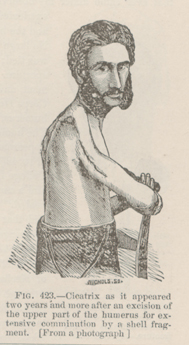Title: Allen, S. C.
Source text: The Medical and Surgical History of the War of the Rebellion. (1861-65.), Part 2, Volume 2 (Washington, DC: Government Printing Office, 1876), 549.
Civil War Washington ID: med.d2e31139
TEI/XML: med.d2e31139.xml
CASE 1524.—Private S. C. Allen, Co. A, 93d New York, aged 21 years, was wounded in the right shoulder by a piece of shell, at Spottsylvania, May 10, 1864. Primary excision of the upper extremity of the humerus was done at the hospital of the Third Division of the Second Corps, in charge of Surgeon O. Evarts, 20th Indiana. The name of the operator was not reported or remembered by the patient, who was sent to Washington, and received at Campbell Hospital on May 14th. Surgeon A. F. Sheldon, U. S. V., noted: "Gunshot fracture of the right humerus at the upper third. The head and five inches of the shaft of the humerus excised through an incision five inches in length. The operation was performed in a field hospital; operator unknown. The patient says he was in good health at the time, and that simple dressings were applied, and that the wound did well." A year subsequently, May 26, 1865, this soldier was transferred, convalescent, to hospital at Albany, and was discharged November 30, 1865, and pensioned. Assistant Surgeon J. H. Armsby, U. S. V., forwarded a picture of the pensioner, taken at the time of his discharge (Contributed Surgical Photographs, A. M. M., Vol. V, p. 10), and an excellent plaster-cast showing the cicatrices of the mutilated shoulder (Spec. 2845, A. M. M.), which Assistant Surgeon Woodhull has described¹ as: "A cast of the right arm, showing the results of primary excision. The head and about four inches of the shaft appear to have been removed. A broad, nearly straight cicatrix on the posterior surface of the arm embraces the wound of exit. A small cicatrix on the anterior surface involves the wound of entrance. The comminuted bone has evidently been removed through enlargement of the wound caused by the missile. There appears to be no bony union at the seat of operation. The shoulder is moderately full." On October 8, 1866, Dr. E. D. Hudson, of New York, fitted Allen with an apparatus, and forwarded the photograph, from which the wood-cut (FIG. 423) is taken, with the following report: "Arm very little shortened, very much atrophied; small fistulous ulcer. New growth of bone, two inches; interspace three inches. Functions of the forearm somewhat impaired; arm much debilitated. The apparatus is very gratifying, improving the functions of his arm, enabling him to carry his hand to his head." The reports of the pension examining surgeons, Dr. W. H. Craig, of Albany, in 1866, and Drs. Boutecou, Craig, and Porter, in 1873, add no new facts. The disability is regarded as total, in the phraseology of the Pension Office. This pensioner was paid March 4, 1874.
¹ WOODHULL (A. A.), Catalogue of the Surgical Section of the Army Medical Museum, 1866, p. 537.
